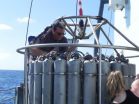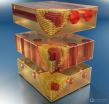(Press-News.org) New research from the University of Southampton has identified a coral-eating flatworm as a potential threat for coral reefs.
It is barely possible to see the parasitic worm Amakusaplana acroporae when it sits on its favourite hosts, the staghorn coral Acropora, thanks to its excellent camouflage. However, the researchers found that the small flatworm could cause significant damage to coral reefs.
The scientists from the University of Southampton, who are based at the Coral Reef Laboratory in the National Oceanography Centre, Southampton, published the results of their research in the latest issue of the journal Coral Reefs, from where it can be freely downloaded - http://link.springer.com/article/10.1007%2Fs00338-013-1101-6
Professor Jörg Wiedenmann, Professor of Biological Oceanography and Head of the University's Coral Reef Laboratory, says: "The biology of this worm is amazing. By using molecular biological techniques, we found out how the worm accomplishes this excellent camouflage: When eating the coral tissue it also takes up the symbiotic alga of the coral. Instead of digesting them completely, it keeps a certain number of them alive and distributes them in its guts so that it perfectly mimics the appearance of the coral. Moreover, it also incorporates the green fluorescent protein pigments that lend the glowing greenish colouration to the coral host to perfect its camouflage."
The flatworm has been scientifically described very recently and has been found in the wild only in one location on the Great Barrier Reef. In contrast, it is well known to aquarium hobbyists who keep staghorn corals and fear infestations of the parasite, since it can wipe out coral cultures within a short period of time.
Professor Wiedenmann explains: "At the moment, there are no known natural predators of this parasite and only consequent quarantine can efficiently control its spread in land-based coral cultures. The worm is already distributed in coral cultures all over the word including regions bordering coral reefs. We do not know whether the parasite occurs naturally in these reefs and if it is controlled by natural enemies there. If this is not the case, a release of the parasite into an environment which is not adapted to its presence might have unforeseeable consequences for the regional Acropora populations."
He adds: "It is important to continue to raise the awareness among aquarium hobbyists that tank inhabitants should never be returned to the wild, since this might unintentionally contribute to the spread of parasites and diseases. Moreover, the hosts of these parasites themselves – corals, fishes and seaweeds – can create dramatic problems for ecosystems to which they are non-native. The spread of the lionfish Pterois through the Caribbean or of Caulerpa algae through the Mediterranean Sea are examples of marine invasions by ornamental species. It would be good if every shop were obliged to take the animals that they have sold back if requested – that would certainly reduce the risk of people releasing ornamental creatures in the wild when they feel that they cannot take care of them anymore."
INFORMATION: END
Devil in disguise: A small coral-eating worm may mean big trouble for reefs
2014-04-11
ELSE PRESS RELEASES FROM THIS DATE:
Brain cell discovery could open doors to targeted cancer therapies
2014-04-11
Fresh insights into the processes that control brain cell production could pave the way for treatments for brain cancer and other brain-related disorders.
Scientists have gained new understanding of the role played by a key molecule that controls how and when nerve and brain cells are formed – a process that allows the brain to develop and keeps it healthy. Their findings could help explain what happens when cell production goes out of control, which is a fundamental characteristic of many diseases including cancer.
Researchers have focused on a RNA molecule, known ...
How nerve cells flexibly adapt to acoustic signals
2014-04-11
Researchers at Ludwig-Maximilians-Universitaet (LMU) in Munich have shown how nerve cells flexibly adapt to acoustic signals: Depending on the input signal, neurons generate action potentials either near or far away from the cell body. This flexibility improves our ability to localize sound sources.
In order to process acoustic information with high temporal fidelity, nerve cells may flexibly adapt their mode of operation according to the situation. At low input frequencies, they generate most outgoing action potentials close to the cell body. Following inhibitory or ...
Study resolves controversy over nitrogen's ocean 'exit strategies'
2014-04-11
A decades-long debate over how nitrogen is removed from the ocean may now be settled by new findings from researchers at Princeton University and their collaborators at the University of Washington.
The debate centers on how nitrogen — one of the most important food sources for ocean life and a controller of atmospheric carbon dioxide — becomes converted to a form that can exit the ocean and return to the atmosphere where it is reused in the global nitrogen cycle.
Researchers have argued over which of two nitrogen-removal mechanisms, denitrification and anammox, is ...
Forging iron women
2014-04-11
Published in the Journal of Nutrition, researchers undertook a systematic review and analysis of the effect of iron supplementation to the exercise performance of women aged from .
Lead researcher, Dr Sant-Rayn Pasricha from the Melbourne School of Population and Global Health found that iron supplementation improved women's exercise performance, in terms of both the highest level they could achieve at 100% exertion (maximal capacity) and their exercise efficiency at a submaximal exertion. Women who were given iron were able to perform a given exercise using a lower ...
Eye of the beholder -- improving the human-robot connection
2014-04-11
Researchers are programming robots to communicate with people using human-like body language and cues, an important step toward bringing robots into homes.
Researchers at the University of British Columbia enlisted the help of a human-friendly robot named Charlie to study the simple task of handing an object to a person. Past research has shown that people have difficulty figuring out when to reach out and take an object from a robot because robots fail to provide appropriate nonverbal cues.
"We hand things to other people multiple times a day and we do it seamlessly," ...
Greenland ice cores show industrial record of acid rain, success of US Clean Air Act
2014-04-11
The rise and fall of acid rain is a global experiment whose results are preserved in the geologic record.
By analyzing samples from the Greenland ice sheet, University of Washington atmospheric scientists found clear evidence of the U.S. Clean Air Act. They also discovered a link between air acidity and how nitrogen is preserved in layers of snow, according to a paper published this week in the Proceedings of the National Academy of Sciences.
Forty-five years ago, acid rain was killing fish and dissolving stone monuments on the East Coast. Air pollution rose beginning ...
Researchers develop ErSb nanostructures with applications in infrared and terahertz ranges
2014-04-11
In a feat that may provide a promising array of applications, from energy efficiency to telecommunications to enhanced imaging, researchers at UC Santa Barbara have created a compound semiconductor of nearly perfect quality with embedded nanostructures containing ordered lines of atoms that can manipulate light energy in the mid-infrared range. More efficient solar cells, less risky and higher resolution biological imaging, and the ability to transmit massive amounts of data at higher speeds are only a few applications that this unique semiconductor will be able to support.
"This ...
The taming of the shrew
2014-04-11
The Borna disease – named after the German city of Borna, which saw a cluster of cases over 100 years ago – mainly affects horses and sheep, and in rare cases cattle and rabbits too. A single case of an infected dog has been reported. Affected horses seclude themselves from the herd and suffer from depression and general disorientation. Ultimately, this incurable infection is fatal.
Borna virus detected in bicoloured shrews
Researchers have long been in the dark concerning the transmission mechanism of the Borna virus. The bicoloured shrew was one suspect, but definitive ...
Nobel prize candidates wait often over 20 years to win their prize
2014-04-11
Candidates for a Nobel prize often have to wait more than 20 years to receive this highest of scientific accolades. According to a Correspondence by Santo Fortunato of Aalto University in Finland and colleagues, such nail-biting delays are becoming the norm — to the point that aspiring laureates may themselves have expired by the time the medal is due to be presented.
Before 1940, Nobel prizes were awarded more than 20 years after the original discovery for only about 11%, 15% and 24% of physics, chemistry and physiology or medicine prizes, respectively. But by 1985, ...
The ATM strikes back
2014-04-11
Its head and pronotum are usually rusty red, and its abdomen blue or shiny green: the bombardier beetle is approximately one centimetre long and common to Central Europe. At first glance, it appears harmless, but it possesses what is surely the most aggressive chemical defence system in nature. When threatened, the bombardier beetle releases a caustic spray, accompanied by a popping sound. This spray can kill ants or scare off frogs. The beetle produces the explosive agent itself when needed. Two separately stored chemicals are mixed in a reaction chamber in the beetle's ...




